Specialty sports with Super-Slant nose
Hidetoshi Aoki
―― Start as successor of Celeste
In 1977, the major facelift project for the Celeste began. The nose was to remain the same, but the rear body was to be drastically changed. At the same time, development of the Celeste successor based on the Lancer EX, which was to be launched two years later, began, but the facelift project was cancelled after some design models were made. The successor, while having “hot and sporty” as its keywords, was required to have improved rear-seat comfort. In addition, the adoption of a turbo engine and retractable headlamps had not been discussed at the beginning, and although various design proposals were made, the characterization of the car had not yet been defined, and time passed in a twisting and turning process.

Early design as successor of Celeste
―― Proposal from Chrysler
Then, in April 1978, there was a reassignment of the staff in charge, and I was put in charge of a new team that included Kaibuchi, Kono, Iwamoto, and myself. About a month later, we received a 1/1 model from Chrysler, our partner at that time. It had an image similar to the Lotus Esprit, with retractable headlights, which were becoming popular in Japan, and 14-inch tires instead of the base car’s 13-inch tires, giving it a hotter image than the Celeste. The car was to be sold by Chrysler as well, and the proposal suggested “this is what we want the car to look like.”

Design proposal from Chrysler
―― Change of base vehicle
Chrysler’s proposal, although rough, had a great impact, and its direction was one that we could say we “got our way.” We also took this opportunity to model retractable headlights and a slant nose with a single motion to the lower edge of the bumper, aiming for a hotter image. However, the Lancer EX base was too small in terms of both body and tire size, and we felt there were limitations in achieving a powerful and sporty design. In addition to the situation in the design department, the proposal from Chrysler may have influenced the decision to change the base model to the 2nd gen. Galant Sigma, aiming for a car that could be compared to a real sports car. At this time, the base position of the windshield was set back 20 mm from the base model, which allowed the long nose and short deck proportions to be achieved, albeit slightly. Around this time, it was also decided to install a turbocharger.
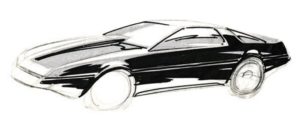
Rough sketch persuing hotter image stimulated by Chrysler’s proposal
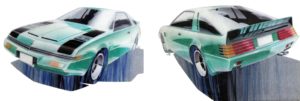
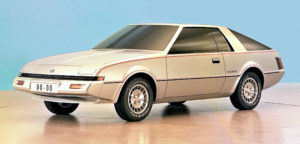
Clay model after base car is changed to 2nd gen. Sigma
―― Aerodynamics and surface treatment
It was written in the media as if the aerodynamics had been taken into consideration from the beginning, but it won’t to be a problem to say now. In fact, at the time of design development, I didn’t fully understand the theory of aerodynamics, and I thought, “It looks cool, doesn’t it, like a sports car?” The front and rear narrowing in the plan view was set to be strong. However, I later learned that this was effective. The design that was later named “super-slant nose” was just an attempt to create a visual impact. We wanted to make the front part more narrow, but gave up on it because the layout was not feasible. Nevertheless, the aerodynamic test results were surprisingly good, but I could have done better if I had been more knowledgeable from the beginning.
To emphasize the distinctive nose, I designed an ultra-thin grille, but there was a concern that the opening would be required to be enlarged due to insufficient cooling airflow. I was prepared for this, and struggled to find a way to accommodate it without compromising the image. However, we were surprised to learn that air flow from the lower part of the bumper was acceptable, and the initial image was directly connected to the production model.
We had also narrowed down the rear portion of the car and said to ourselves, ” Now it looks more like a sports car.” When we presented the model to President Kubo, he kicked us out, saying,”No, not like a catfish like this! ” So, we decided to reduce the narrowing of the body and narrow the quarter glass to create a surface that would connect to the ducktail, thereby eliminating the catfish image. At the next presentation the president tapped the surface and said, “This shelf is no good. In fact, you lack sensitivity. Make a surface with more sensitivity. ” I had heard him say, “You people have bad taste,” from time to time, but I was surprised to hear him say, “More sensitivity.” We all wondered, “What is a surface treatment with high sensitivity?” We managed to create a shape that would lead to a production car and received the president’s approval, but was it really with high sensitivity?
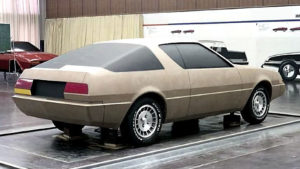
Design described as ”catfish” as result of narrowing rear
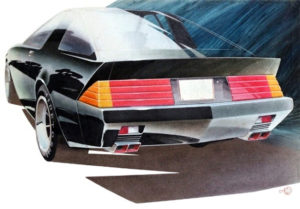
―― Costly design
North American regulations at the time required the installation of passive seat belts, and an engineering proposal to install anchor points at the upper rear end of the doors was emerged. This was a good match with the president’s opinion that the B-pillar should be sloped in the opposite direction from the usual to give it more character. Therefore, the sashless design was abandoned in favor of a one-piece pressed door that would match the reverse slope of the B-pillar. This design allowed the rear edge of the lower part of the door to be moved forward, and the expansion of the trajectory when opening and closing the door was suppressed, but the larger door still caused problems in terms of ease of getting in and out of the car. The body engineers improved this problem by adopting double-pivot hinges that allow the front edge of the door to move outward when opening and closing.
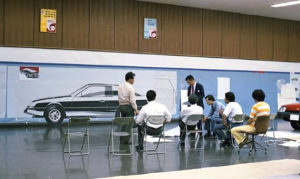
Writer (foreground) at design review meeting in design section
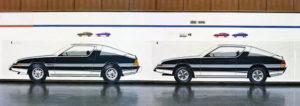
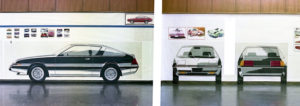
Studying various doors and quarter panels with tape drawings
The rear of the cabin consisted of narrow C-pillars and a glass hatch, but when the opening was at the rear edge of the glass, the loadability would not be good. Simply connecting the ducktail to the rear edge of the glass to extend the opening would not work because the sealing surface would not be continuous. The body engineers came up with a surprising solution to this problem. By extending the glass to the back of the ducktail and then bending the back end downward to create a continuous sealing surface, the opening was set back and at the same time lowered in height. The ducktail rests on top of the bent glass, which is not visible from outside. Whether it is the doors or the rear gate, it was generous to spend money on parts that are not visible. I felt that much cost was spent to give priority to the styling of the car.
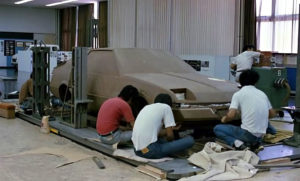
Thanks to modelers who helped us with many clay models
―― Notchback model
It is not widely known, but during the development process, it was decided to make a notchback model based on the fastback model and sell it at the Car Plaza dealerships that existed at the time. This was intended to compete with the then popular Prelude and the Silvia (both notchbacks). In the early stages of development, the car had been developed with sashless doors, which allowed for a degree of freedom in design, including the roof line, but this was diminished when the doors were changed to one-piece pressed doors. However, Ryu Kaibuchi, who was in charge of the design, used sharp-vented glass for the rear window, creating a very unique design. Many people in the company were attracted to this design, but I wonder what would have happened if it had been launched.

Notchback model planned for Car Plaza sales channel
―― Launching postponed for a year
After the design decision was made, development was proceeding smoothly until an unexpected event occurred: the second oil crisis in 1978. This caused the public to think that “turbochargers are out of the question,” and the launch schedule for 1981 was frozen. In spite of the concern over the future, the impact did not last long, and in March 1982, the car was unveiled at the Geneva Show before going on sale in Japan. The company was very eager, and the expected competitor was the Porsche 924 Turbo. On the other hand, the notchback model was cancelled. It was a shame, because I think it had enough potential to compete in the market.
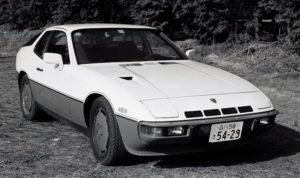
Porshe 924 turbo Photo courtesy of Motor Fan/ CAR STYLING
If it had been launched a year earlier, a design similar to the super-slant nose would have been almost non-existent and a significant feature of the Starion. However, the postponement caused other companies to come out with similar design. Although competitors would have understood that it was impossible to produce a similar design within a year or so, it was generally accepted as a “copycat,” and this was frustrating for me.
―― Regret
In those days, the mainstream design treatment was to have a peak line on the body side at the height connecting the front and rear bumpers, and this treatment was used on all the models in this project from the beginning. My design proposal was the same, but as the design process progressed, I gradually came to feel that this treatment made the center of gravity look too low, giving the car too much stability, and that it lacked the ” image of dynamism” that is necessary for a sports car. After trying various alternatives, I decided to add another character line slightly above the peak line, which would give the car a more dynamic and sporty image by raising the visual center of gravity while enhancing the tumblehome. However, once that clay model was completed, I then felt that there were too many lines on the sides, and I was thinking of boldly eliminating the lower line, but the design was approved unexpectedly quickly and I missed the opportunity to do so. I regretted that I should have made two proposals for the left and right sides of the clay model, but it was too late. The result might have been the same even if I had done so.
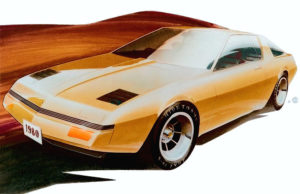
Style that writer wanted to accomplish
―― Looking back
Since my childhood, I have loved to draw “imaginary drawings” and even built a model of a car of my own design when I was in junior high school. When I grew up, I was able to sneaked into an automobile company as a designer. I think that anyone who has chosen this profession would at one time or another want to design a sports car. However, there are various hurdles that cannot be overcome only by one’s ability, and there are not many chances to have one’s wishes realized. It is not only affected by chance and the luck of timing, and even if you become a member of the development team, there is no guarantee that your idea will be adopted. In such a situation, I was very fortunate to be able to represent many of the things I wanted to do in a car that was similar to a sports car. During my tenure, I was involved in a variety of car designs, but the one that left the greatest impression on me was the STARION.
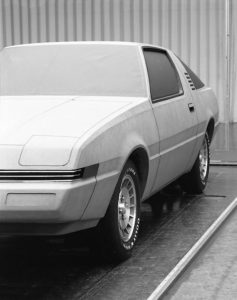
October 2021
Challenging High-tech image
Toshihiro Ito
―― Start of Design
The Starion was planned as a sports car mainly for the domestic and the North American markets, but at first the specific characterization of what it would be was not yet determined. Eventually, however, it was decided that the car would be a high-performance, specialty sports car equipped with an ECI turbo engine and comparable to a Porsche. By mid-1978, the basic layout had been finalized, the exterior design had taken shape to some extent, and the windshield line and the belt line that would form the basis of the interior design had been established. Finally, we were able to begin the interior design in earnest.
―― High-tech image
By then, Mitsubishi’s sports type cars had begun with the Galant GTO, followed by the Galant coupe FTO, the Lancer Celeste and the Galant Lambda. The 2nd-gen. Galant Lambda, sold in parallel with the Stallion, was more of an elegant two-door coupe, and as a result, it was inevitable that the Starion would take a more sports car-like direction. Therefore, the instrument panel design was to concentrate functions around the driver’s seat to achieve high operability and visibility, while the front seats were designed to hold the passenger as much as possible to ensure a safe and secure driving experience. In addition, we aimed to create a high-tech atmosphere throughout the interior. The term “high-tech” became popular around the world in the late 1970s, exactly when I was engaged in this work. It was a time when the evolution of the automobile industry from analog technology to electronics-based technology was greatly accelerated, and this was a field in which Japan excelled at the time. Therefore, we thought that a high-tech design would be a major distinguishing feature of this car against cars from Europe and the United States.
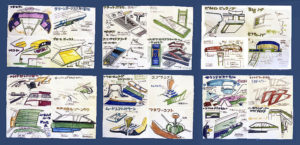
Broad idea development done at beginning
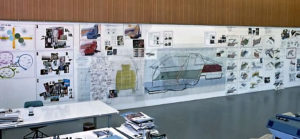
―― Floating instrument panel
Various ideas were sketched for the instrument panel design, and among them, a proposal to lower the top of the instrument panel and concentrate functional parts around the meter cluster was highly evaluated, and the design was narrowed down to that direction. This design gave the impression of a floating instrument cluster on a shelf, and we came to call it a “floating instrument panel,” which clarified the design image we were aiming for. However, although we clearly expressed the floating image in the initial idea sketches, we were forced to compromise on the formability of the design during the final design stage, and in the end, the image faded somewhat unfortunately.
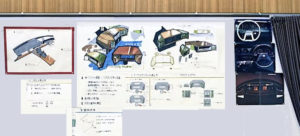
Design study of “floating instrument panel”
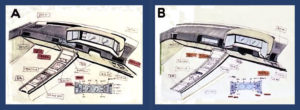

Idea sketches and renderings in early stages
The most profound consideration in the design of this instrument panel was how the area around the meter cluster should look for the driver. In addition to visibility and operability, we struggled to create an advanced, high-tech image. Specifically, six switches for lighting, hazards, and other functions were placed on either side of the wide meter cluster unit. This was because the switches were located just ahead of the steering wheel, which makes them easy to operate. However, when we actually tried it, we found that neither too far nor too close to the steering wheel gave a good operating feel, and we spent a lot of time coordinating with the testing department and the engineering department to find the optimal position of the switches. We also proposed touch-type switches with electronic sounds to give these switches a high-tech feel, but the proposal was rejected on the grounds that the lack of a sense of operation would make people feel uneasy, and we ended up using the conventional mechanical type. However, since touch-type switches became widely used after that, they might have been adopted if the time period had been a little later.

Initial interior model
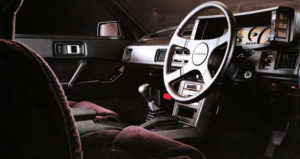
Interior of production model
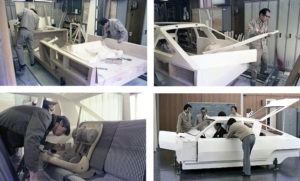
Interior model fabricated by collaborating model company
―― Never realized “black face”
As for the gauges, the LCD electronic meter, which had not yet been adopted in competitors’ models, were installed in high-end models, while the standard models were with analog meter. Then I proposed the idea of a transparent illumination type “black face” for this analog meter. This was the first of its kind in the world at the time, a completely black instrument panel that emitt light as soon as the key is turned on. I planned a prototype model of this meter with a fluorescent lamp inside and installed it in an interior approval model. The effect was outstanding, and the presentation was a great success and much appreciated. However, my efforts were not rewarded, as the cost was too high and it was not adopted. However, in 1989, seven years after the launch of the Starion, the “black face” meter was introduced to the world for the first time in the Toyota Celsior. I still regret that it was not adopted at that time.
To further characterize the meter cluster, I focused on the use of a flock coating to give the cluster surface a suede-like appearance, and worked with the engineers and the vendors to make this happen. I thought that the softness of suede would create a higher quality atmosphere than the hard surface of plastic. This was also reflected in the interior model, but unexpectedly, there was strong resistance from those involved, and the idea was scrapped. This unprecedented look had a bit too much impact.
―― Full Support Seat
While designing this interior, I went to the 1978 Turin Auto Show with related people to do research, and we found the seats of the Renault Cinq sports model interesting, and purchased it after returning to Japan. We used this seat and others as references and came up with the concept of a new type of seat called a “full support seat” that would fit any physique. The goal was to design a seat that would provide optimum support to the various parts of the person seated in it.
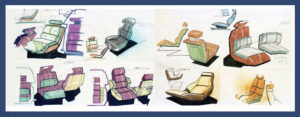
Idea sketches for the seat
First, a plastic foam model was made as a design study model, and based on this model, we designers, the engineers, and the vendor repeatedly examined the feasibility of the design. After that, a prototype seat was fabricated, and the hold and ease of getting in and out of the seat were checked and improved over and over again. In addition, because of the unique shape of the seat, the sewing of the seat fabric was also repeatedly examined. In this way, the “full support seat,” which at first seemed to be a very high goal, was finally designed to be satisfactory as a seat that can be adjusted in six different ways. I am grateful for the cooperation of the engineers and the vendor.
In addition, we made various other proposals, such as a single slide rail for better leg room, a swivel seat for easy entry and exit, a comfortable footrest for the passenger seat, and the electrification of functional operating parts, but many of these proposals were abandoned due to structural, weight, and cost considerations.
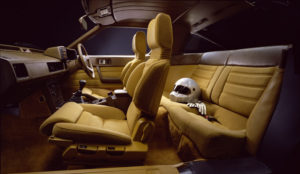
―― Reliable relationship
Looking back on those days, we tried so many things on the interior of the Starion that it could be a bit too much. There were many things that did not turn out the way we wanted, such as the “black face” meter, but I believe that you can never know everything unless you try first, and having a lot of things you want to do is never a bad thing. I believe that it is important to have a strong relationship of reliability with those who are involved in the development of new products.
Nobember 2021